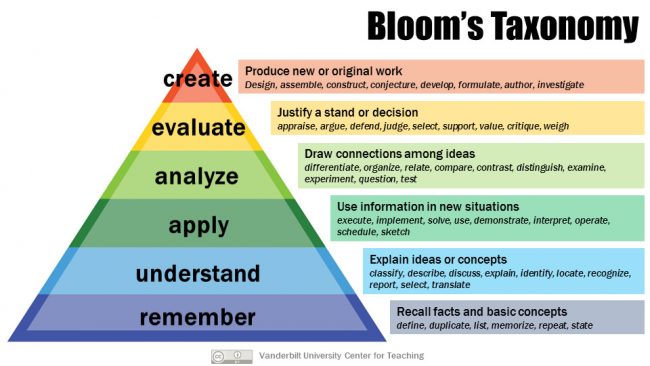
Lesson Objective: The lesson objective states what students will know or be able to do at the end of the lesson. The strategies, materials, assignments, and assessments used in a lesson are determined by, and must align with, the lesson objective. Therefore, lesson planning begins with the end in mind.
When planning lessons, GOALS describe the lesson’s summative outcomes (where students will go) and the OBJECTIVES describe how students will get there.
Include SMART attributes when writing objectives:
S-Specific: Concise, well-defined statements of what students will know, understand, and be able to do at the end of the lesson. The objective should state exactly what is to be accomplished by the student and the conditions in place, such as, “Given a topic on American history”, “Provided with a calculator and a three minute time limit”, or “Independently, following the five-step scientific method”.
Learning outcomes should be simply stated in student-centered terms. If students are aware of the intended outcome, then they know where their focus should lie. This clarity helps decrease anxiety about their ability to succeed and helps build intrinsic motivation.
M-Measurable: Learning objectives must be quantifiable. Measurable objectives state the outcomes that can be assessed in definite and specific ways; the quality or level of performance that will be considered acceptable (mastery level). The criterion can be expressed by describing the performance standard to be met, such as, “Write a descriptive paragraph that includes a topic sentence, three supporting detail sentences, and a closing sentence.” When writing mastery level, you often begin with the word “with”, then add description, such as “90% accuracy”, “no errors”, “appropriate punctuation” or “accurate vocabulary”.
Start with behavioral verbs (action verbs) that can be observed (either informally or formally) and measured. Using concrete verbs will help keep your objectives clear and concise. Bloom’s Taxonomy provides a list of such verbs and these are categorized according to the level of achievement at which students should be performing.

While the verbs above clearly distinguish the action that should be performed, there are verbs to avoid when writing a learning objective. The following verbs are too vague or difficult to measure: appreciate, cover, realize, be aware of, familiarize, study, become acquainted with, gain knowledge of, comprehend, know, learn, understand, learn.
A-Attainable: Learning objectives should be written at the appropriate developmental level for student success. It is essential that students have the pre-requisite knowledge and skills and that the lesson’s time frame supports achievement of the objective. You can determine the appropriate level of challenge by referring to pre assessment results. Learning activities should be challenging, yet offer students a realistic chance to master the objective.
R-Relevant: The skills or knowledge described must be appropriate for the grade level and subject area or an individual’s IEP goals. The process of setting learning objectives begins with knowing the specific standards, benchmarks, and supporting knowledge students in your school or district are required to learn. Common Core State Standards and curriculum documents are the source for this information. This is essential to ensure students receive the same important content from teacher to teacher.
T-Time-bound: Time-bound – State when students should be able to demonstrate the skill (“By the end of the lesson” , etc.).
Note: As you complete your clinical experiences, it will be expected that written lesson objectives present all of the attributes of a SMART Goal. You may write more than one lesson objective for a single lesson as a result of grouping your students in response to their needs. Determination of the need for more than one objective will be the result of your analysis of students’ current performance (formative assessment).
SMART GOAL EXAMPLES
(Center for Educational Resources – John Hopkins University, The Innovative Instructor Blog-Marcia Hall, July 2016; Designing Lessons for the Diverse Classroom, Bureau of Instructional Support and Community Services, Division of Public Schools and Community Education, Florida Department of Education)
Section 1a calls for a lesson goal/objective, an introductory criteria to lesson planning. As discussed above, this lesson goal should be written as a SMART goal and clearly articulate what students should know and/or be able to do at the end of the lesson.
In subsequent lessons, this objective will be revised and adapted based on evidenced student progress toward the objective. In other words, students who master the objective move on to more complex and/or new skills in subsequent lessons. Others who are unable to demonstrate mastery yet might continue to target this lesson objective in upcoming small group lesson activities that provide remediation and support.
The best lesson objectives require that students utilize higher order/deep thought processes. Goals that target learning (versus completion) are more likely to be connected to quality learning experiences that stretch students’ thinking, foster self-reflection, and encourage transfer of skills. Lesson objectives that are learning oriented (EX: “Students will accurately describe four cause and effect relationships” vs “Students will accurately answer four of five comprehension questions”) focus on the actual skill that the lesson objective targets.